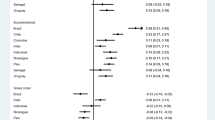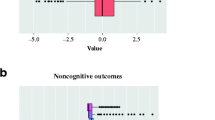Abstract
In recent years, a large body of research has investigated the various factors affecting child development and the consequent impact of child development on future educational and labor market outcomes. In this article, we contribute to this literature by investigating the effect of handedness on child development. This is an important issue given that around 10% of the world’s population is left-handed and given recent research demonstrating that child development strongly affects adult outcomes. Using a large, nationally representative sample of young children, we find that the probability of a child being left-handed is not significantly related to child health at birth, family composition, parental employment, or household income. We also find robust evidence that left-handed (and mixed-handed) children perform significantly worse in nearly all measures of development than right-handed children, with the relative disadvantage being larger for boys than girls. Importantly, these differentials cannot be explained by different socioeconomic characteristics of the household, parental attitudes, or investments in learning resources.
Similar content being viewed by others
References
Aggleton, J.P., R.W. Kentridge, and J.M.M. Good. 1994. “Handedness and Musical Ability: A Study of Professional Orchestral Players, Composers, and Choir Members.” Psychology of Music 22:148–56.
Annett, M. 1985. Left, Right, Hand and Brain: The Right Shift Theory. London: Lawrence Earlbaum.
— 1992. “Spatial Ability in Subgroups of Left- and Right-Handers.” British Journal of Psychology 83:492–515.
Annett, M. and D. Kilshaw. 1982. “Mathematical Ability and Lateral Asymmetry.” Cortex 18:547–68.
Annett, M. and M. Manning. 1989. “The Disadvantage of Dextrality for Intelligence.“ British Journal of Psychology 80:213–26.
Bailey, L.M. and W.F. McKeever. 2004. “A Large-Scale Study of Handedness and Pregnancy/Birth Risk Events: Implications for Genetic Theories of Handedness.” Laterality 9:175–88.
Bakan, P., G. Dibb, and P. Reed. 1973. “Handedness and Birth Stress.” Neuropsychologia 11:363–66.
Baxter, J. 2007. “Children’s Time Use in the Longitudinal Study of Australian Children: Data Quality and Analytical Issues in the 4-year Cohort.” Technical Paper No. 4. Australian Institute of Family Studies, Melbourne.
Benbow, C.P. 1986. “Physiological Correlates of Extreme Intellectual Precocity.” Neuropsychologia 24:719–25.
— 1988. “Sex Differences in Mathematical Reasoning Ability in Intellectually Talented Preadolescents: Their Nature, Effects and Possible Causes.” Behavioural and Brain Sciences 11:169–232.
Bianki, V.L., E.B. Filippova, V.A. Shramm, K.B. Magnitskaya, and E.V. Kharitonov. 1996. “Audio-Verbal and Visuo-Spatial Memory of Elementary School Children With Varying Lateral Profiles.” Human Physiology 22:296–301.
Bishop, D.V.M. 1990. Handedness and Developmental Disorder. London: Lawrence Erlbaum.
Blau, D.M. 1999. “The Effect of Income on Child Development.” Review of Economics and Statistics 81:261–76.
Bryden, M.P., E.A. Roy, I.C. McManus, and M.B. Bulman-Fleming. 1997. “On the Genetics and Measurement of Human Handedness.” Laterality 2:317–36.
Bryden, P.J., J. Bruyn, and P. Fletcher. 2005. “Handedness and Health: An Examination of the Association Between Different Handedness Classification and Health Disorders.” Laterality 10:429–40.
Cerone, L.J. and W.J. McKeever. 1999. “Failure to Support the Right-Shift Theory’s Hypothesis of a ‘Heterozygote Advantage’ for Cognitive Abilities.” British Journal of Psychology 90:109–23.
Chapman, L.J. and J.P. Chapman. 1987. “The Measurement of Handedness.” Brain and Cognition 6:175–83.
Corballis, M.C. 1991. The Lopsided Ape. New York: Oxford University Press.
Corballis, M.C., J. Hattie, and R. Fletcher. 2008. “Handedness and Intellectual Achievement: An Even-Handed Look.” Neuropsychologia 26:374–78.
Coren, S. 1992. The Left-Hander Syndrome: The Causes and Consequences of Left-Handedness. New York: The Free Press.
— 1995. “Differences in Divergent Thinking as a Function of Handedness and Sex.” American Journal of Psychology 108:311–25.
Crow, T.J., L.R. Crow, D.J. Done, and S. Leask. 1998. “Relative Hand Skill Predicts Academic Ability: Global Deficits at the Point of Hemispheric Indecision.” Neuropsychologia 36:1275–282.
Cunha, F., J.J. Heckman, L.J. Lochner, and D.V. Masterov. 2006. “Interpreting the Evidence on Life Cycle Skill Formation.” Pp. 697–812 in Handbook of the Economics of Education, edited by E.A. Hanushek and F. Welch. Amsterdam: North-Holland.
Dancey, C.P., A.E. Attree, G. Bàrdos, and A. Kovacs. 2005. “Is There a Link Between Irritable Bowel Syndrome and Left-Handedness?: An Exploratory Study.” Integrative Physiological & Behavioral Science 40:55–59.
Dane, S. and K. Gumustekin. 2002. “Handedness in Deaf and Normal Children.” International Journal of Neuroscience 112:995–98.
Denny, K. and V. O’Sullivan. 2007. “The Economic Consequences of Being Left-Handed: Some Sinister Results.” Journal of Human Resources 42:353–74.
Faurie, C., N. Vianey-Liaud, and M. Raymond. 2006. “Do Left-Handed Children Have Advantages Regarding School Performance and Leadership Skills?” Laterality 11:57–70.
Fox, N.A. 1985. “The Relationship of Perinatal Birth Status to Handedness: A Prospective Study.” Infant Mental Health Journal 6:175–84.
Fry, C. 1990. “Left-Handedness: Association With College Major Familial Sinistrality, Allergies, and Asthma.” Psychological Reports 67:419–33.
Geschwind, N. and P. Behan. 1982. “Left-Handedness: Association With Immune Disease, Migraine, and Developmental Learning Disorder.” Proceedings of the National Academy of Sciences of the United States of America 79:5097–100.
Giagazoglou, P., E. Fotiadou, N. Angelopoulou, J. Tsikoulas, and V. Tsimaras. 1997. “Gross and Fine Motor Skills of Left-Handed Preschool Children.” Perceptual and Motor Skills 92:1122–28.
Good, J.M.M., J.P. Aggleton, R.W. Kentridge, J.G.M. Barker, and N.J. Neave. 1997. “Measuring Musical Aptitude in Children: On the Role of Age, Handedness, Scholastic Achievement, and Socioeconomic Status.” Psychology of Music 25:57–69.
Gray, M. and A. Sanson. 2005. “Growing Up in Australia: the Longitudinal Study of Australian Children.” Family Matters 72:4–9.
Guo, G. 2000. “The Mechanisms Mediating the Effects of Poverty on Children’s Intellectual Development.” Demography 37:431–47.
Gurd, J.M., J. Schulz, L. Cherkas, and G.C. Ebers. 2006. “Hand Preference and Performance in 20 Pairs of Monozygotic Twins With Discordant Handedness.” Cortex 42:934–45.
Halpern, D.F., M.G. Haviland, and C.D. Killian. 1998. “Handedness and Sex Differences in Intelligence: Evidence From the Medical College Admission Test.” Brain & Cognition 38:87–101.
Haveman, R. and B. Wolfe. 1995. “The Determinants of Children’s Attainments: A Review of Methods and Findings.” Journal of Economics Literature 33:1829–78.
Heckman, J.J. 2006. “The Economics of Investing in Early Childhood.” Presentation given at The Niftey Conference, University of New South Wales, Sydney, February 8.
Heilman, K.M. 2005. Creativity and the Brain. New York: Psychology Press.
Heinz, M. and W. Heinz. 2002. “No Deficits at the Point of Hemispheric Indecision.” Neuropsychologia 40:701–704.
Hermelin, B. and N. O’Connor. 1986. “Spatial Representations in Mathematically and in Artistically Gifted Children.” British Journal of Educational Psychology 56:150–57.
Inskip, P.D., R.E. Tarone, A.V. Brenner, H.A. Fine, P.M. Black, W.R. Shaprio, R.G. Selker, and M.S. Linet. 2003. “Handedness and Risk of Brain Tumours in Adults.” Cancer Epidemiology Biomarkers & Prevention 12:223–25.
Johnston, D.W., M. Shah, and M.A. Shields. 2007. “Handedness, Time Use and Early Childhood Development.” IZA Discussion Paper No. 2752. Institute for the Study of Labor, Bonn, Germany.
Ku, I. and R. Plotnick. 2003. “Do Children From Welfare Families Obtain Less Education?” Demography 40:151–70.
McKeever, W.F. 1986. “The Influences of Handedness, Sex, Familial Sinistrality and Androgyny on Language Laterality, Verbal Ability, and Spatial Ability.” Cortex 22:521–37.
McManus, I.C. 2002. Right Hand, Left Hand: The Origins of Asymmetry in Brains, Bodies, Atoms and Cultures. London: Weidenfeld and Nicolson.
McManus, I.C. and C.G.N. Mascie-Taylor. 1983. “Biosocial Correlates of Cognitive Abilities.“ Journal of Biosocial Science 15:289–306.
McManus, I.C., S. Shergill, and M.P. Bryden. 1993. “Annett’s Theory That Individuals Heterozygous for the Right-Shift Gene Are Intellectually Advantaged: Theoretical and Empirical Problems.” British Journal of Psychology 84:517–37.
Meng, L. 2007. “The Rate of Handedness Conversion and Related Factors in Left-Handed Children.” Laterality 12:131–38.
Michel, G.F., A.N. Tyler, C. Ferre, and C. Sheu. 2006. “The Manifestation of Infant Hand-Use Preferences When Reaching for Objects During the Seven- to Thirteen-Month Age Period.” Developmental Psychobiology 48:436–43.
Miller, J.W., S. Jayadev, C.B. Dodrill, and G.A. Ojemann. 2005. “Gender Differences in Handedness and Speech Lateralization Related to Early Neurologic Insults.” Neurology 65:1974–75.
Nettle, D. 2003. “Hand Laterality and Cognitive Ability: A Multiple Regression Approach.” Brain and Cognition 52:390–98.
Oldfield, R.C. 1971. “The Assessment of Handedness: The Edinburgh Inventory.” Neuropsychologia 9:97–133.
Orton, S.J. 1937. Reading, Writing and Speech Problems in Children. New York: Norton.
Paxson, C. and N. Schady. 2007. “Cognitive Development Among Young Children in Ecuador: The Roles of Wealth, Health, and Parenting.” Journal of Human Resources 42:49–84.
Peters, M. 1991. “Sex, Handedness, Mathematical Ability, and Biological Causation.” Canadian Journal of Psychology 45:415–19.
Peters, M., S. Reimers, and J.T. Manning. 2006. “Hand Preference for Writing and Associations With Selected Demographic and Behavioural Variables in 255,100 Subjects: The BBC Internet Study.” Brain & Cognition 62:177–89.
Peterson, J.M. and L.M. Lansky. 1977. “Left-Handedness Among Architects: Partial Replication and Some New Data.” Perceptual and Motor Skills 45:1216–18.
Pipe, M.E. 1987. “Pathological Left-Handedness: Is It Familial?” Neuropsychologia 25:571–77.
Piro, J.M. 1998. “Handedness and Intelligence: Patterns of Hand Preference in Gifted and Nongifted Children.” Developmental Neuropsychology 14:619–30.
Porac, C. and S. Coren. 1977. Lateral Preferences and Human Behavior. New York: Springer-Verlag.
Preti, A. and M. Vellante. 2007. “Creativity and Psychopathology: Higher Rates of Psychosis Proneness and Nonright-Handedness Among Creative Artists Compared to Same Age and Gender Peers.” Journal of Nervous and Mental Disease 195:837–45.
Ramadhani, M., I. Koomen, D. Grobbee, C. van Donselaar, A.M. van Furth, and C. Uiterwaal. 2006. “Increased Occurrence of Left-Handedness After Severe Childhood Bacterial Meningitis: Support for the Pathological Left-Handedness Hypothesis.” Neuropsychologia 44:2526–32.
Resch, F., J. Haffner, P. Parzer, U. Pfueller, U. Strehlow, and C. Zerahn-Hartung. 1997. “Testing the Hypothesis of the Relationships Between Laterality and Ability According to Annett’s Right-Shift Theory: Findings in an Epidemiological Sample of Young Adults.” British Journal of Psychology 88:621–35.
Ruebeck, C.S., J.E. Harrington Jr., and R. Moffitt. 2007. “Handedness and Earnings.” Laterality 12:101–20.
Ruhm, C.J. 2004. “Parental Employment and Child Cognitive Development.” Journal of Human Resources 39:155–92.
Satz, P., D.L. Orsini, E. Saslow, and R. Henry. 1985. “The Pathological Left-Handedness Syndrome.” Brain and Cognition 4:27–46.
Snyder, P.J. and L.J. Harris. 1993. “Handedness, Sex, and Familial Sinistrality Effects on Spatial Tasks.” Cortex 29:115–34.
Taylor, B.A., E. Dearing, and K. McCartney. 2004. “Incomes and Outcomes in Early Childhood.” Journal of Human Resources 39:980–1007.
Waldfogel, J., W. Han, and J. Brooks-Gunn. 2002. “The Effects of Early Maternal Employment on Child Cognitive Development.” Demography 30:369–92.
Williams, S.M. 1987. “Differences in Academic Performance at School Depending on Handedness: Matter for Neuropathology?” Journal of Genetic Psychology 148:469–78.
Wood, C.J. and J.P. Aggleton. 1991. “Occupation and Handedness: An Examination of Architects and Mail Survey Biases.” Canadian Journal of Psychology 45:395–404.
Author information
Authors and Affiliations
Additional information
Direct correspondence to Michael A. Shields, Department of Economics, The University of Melbourne, Victoria, 3010 Australia
Rights and permissions
About this article
Cite this article
Johnston, D.W., Nicholls, M.E.R., Shah, M. et al. Nature’s experiment? Handedness and early childhood development. Demography 46, 281–301 (2009). https://doi.org/10.1353/dem.0.0053
Issue Date:
DOI: https://doi.org/10.1353/dem.0.0053




